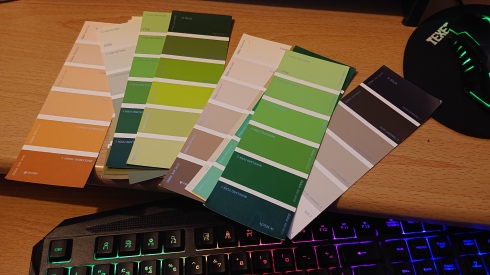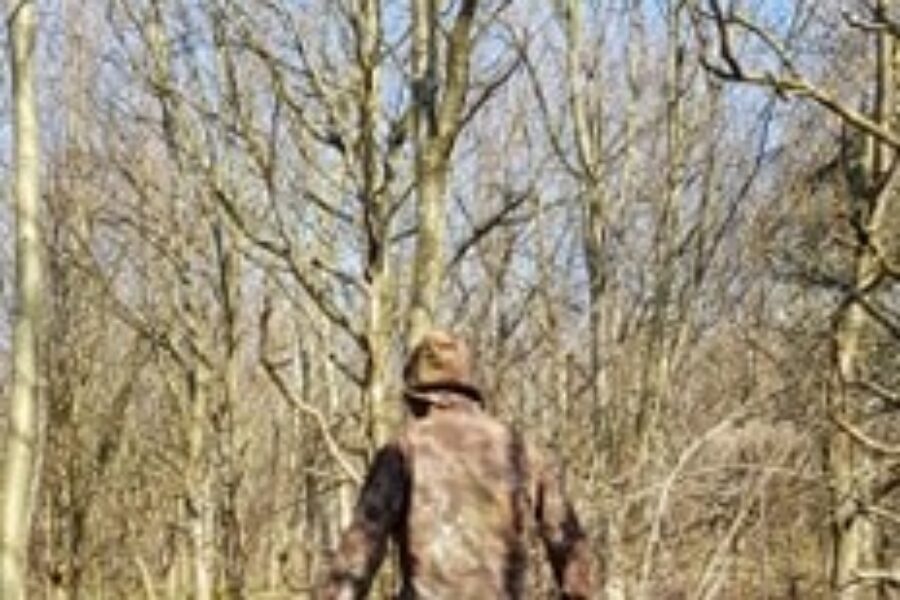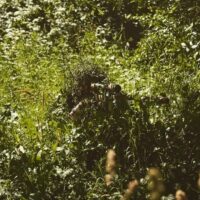Getting colours right

Pic – Lars Lyhne Lundqvist
How do you go about getting colours to match the environment you play in? One of the most common issues with a lot of suits, although brilliantly made to add depth and texture, is simply getting the colours wrong. A ghillie colour matched perfectly even with no decoration will work better than a well constructed leaf suit that is totally mismatched with its environment. Getting it right begins way back at the start, where you pick your base suit, so what is it you should be looking at before adding anything to your cart?
I’ll start by talking a little about some of the sites I play at locally. The main one is Dirty Dog Airsoft, which is a mix of grassy fields, light woodland and urban. Obviously there’s a clash there between the grass and the woodland, which really require two different suits because of the contrast. I have a proper woodland site nearby too, NTAC, which suits dark browns and has a lot of leaves on the floor, and on the whole is a very easy site to make camouflage for. Then there’s a very big one, Raw, which is mainly a mix of birch woodland (very light in colour, lots of grass and other stuff growing in it) and pine forest (lots of dark browns and oranges). Because of this variation of environment, I experimented with a range of suits and materials and have ended up with several different setups. Beyond that, I do like to travel to play and every site will throw up a different combination, which makes a “one suit for all” solution impossible. How do you avoid being seen?
Seeing vs noticing. It’s something I’ve always said to people asking about starting suit builds.
“It’s not about whether they SEE you, it’s about whether they NOTICE you”.
What I mean by that is this. If you were to flick through social media you’ll often find pictures of snipers in an environment and they’ll be showing off their camouflage and asking “can you spot me”. Obviously it’s a staged photo, and some are really difficult to see, which is great. But when you look at that picture, you’re told there’s a sniper in it somewhere. You know. And you look.
In game, assuming you’ve been able to move stealthily into a position and you come across some patrolling enemy players, they don’t know you’re there, and this is key. What you want from your suit is for nothing to give you away. In the unlikely event these players are alert, they’ll be scanning the area for your team. If there’s a dark shadowy figure, or you have bright orange plastic leaves, tall waving ferns or something else that might highlight your position, then you’ve put yourself at risk. If they’re scanning the area and their eyes pick up lots of similar colours, the eyes won’t recognise what they’re seeing as being anything other than boring natural things like dirt, grass, branches etc.
As well as the very different locations we play in and the different combinations of vegetation, there’s also seasons to take into account. Not four, but I work off two. Winter and summer. There’s about 4 months of summer where everything is a very bright green, then there is sniper season – winter – where everything changes to browns and tans and it rains a lot…
Here’s a couple of pictures to highlight the main point of this article. The first one is me in a woodland leaf suit, in the wrong part of the site, with a very dark brown silhouette. The thing I hate about leaf suits is that, although up close some do have a nice woodland type print on them, from even a short distance this blurs into one big dark human shaped outline, and on a lot of facebook groups and other forums, the advice immediately given is that the base suit is too bright – which is correct because it’s new and clean – and the solution to “dull it down” is usually to dye it with dark brown Idye poly. So what you end up doing isn’t to dull your suit, but enhance that dark silhouette by making it darker.

Granted, if your local site was a dark woodland site with a lot of dark browns, leaves everywhere, then that’s not too bad, although you will find that dark brown poly dye is quite a rich colour. Here’s the second pic. Similar area, better colour matching.

Same suit, same site but a return visit with a few colour changes. It’s not perfect, but not bad considering I just lay in the grass, with no intent to hide (our base was under attack so I jumped in to put some fire into the advancing enemy). I had to attack the leaf suit with a lot of tan spray paint, although the mesh doesn’t take colour as well as BDU’s so inbetween leaves there was still a silhouette. It had no extra work done in terms of slapping more 3D elements on, simply a colour adjustment. It helped a little.
To go back to that first picture of me in a dark brown leaf suit in the grass, you’d be able to pick me out from 200m away by looking across the field I’m in. The silhouette is far too distinct. If I had some kind of basic green and tan camo on, even if it wasn’t 3D and wasn’t at all decorated, there’d be much less of a chance because the colours would blend into the background.
Attention to colour is key.
You need to carefully choose your base, whether it be a ghillie cape, suit, leaf suit, or just bdu’s. If you’re building for a lighter coloured environment, look for a lighter coloured suit. It’s easy to darken colours, but very difficult to lighten. Additionally, just darkening colours isn’t the answer. Nature simply isn’t dark brown and bright green. Look closely at your environment. The stuff you’re trying to replicate has been out in the sun, pale and bleached. It’s been out in rain, covered in dirt and animal excrement. Compare it to the shiny polyester leaf suits.
Choosing BDU’s for the environment
A leaf suit may be a popular and easy option, but BDU’s offer a much greater range of colours and patterns to better match your environment, and unless you’re willing to spend a lot of money on a base, a more robust solution to boot. Far better to have an adaptable range of coloured BDU’s with the appropriate 3D elements. Followers of Le Covert Sartorialist on Facebook will be familiar with the method of using spray paints to further alter the base colours and patterns to better match what you need (not like you’ll be washing your suit anyway). In his words, you need to match the 2D to the environment first before you add the 3D elements, which makes it far more effective; if you don’t get the base right then you end up adding too much 3D camo trying to hide it. Yes, the leaf suit gives you lots of outline disruption at close range – though that effect is lost further away – but a fuzzy outline on a dark blob doesn’t hide the dark blob. If you were doing things properly, and had a few different suits for different environments or seasons, a few expensive leaf suits which need modifying all the same anyway will quickly empty your bank account. Picking the right base camouflage does require some thought though, and don’t always assume the popular ones are going to be the best.

This is a winter photo of the Head Marshal at Dirty Dog, Richie. He’s a lethal sniper and someone I’ve learned a lot from. He’s wearing desert DPM which has a very slight olive dye, and although there’s nothing else attached, it’s almost impossible to find him even in a Spot the Sniper photo. The colour match is superb to the terrain, although this isn’t your typical “woodland” camouflage. His camouflage doesn’t cast a dark shadow against the backdrop here and it’s the shadow of a human outline that our eyes are trained to pick up on. It’s also become a less common camouflage and maybe disappearing from memory.

Here’s my desert DPM suit after some work with spray paints.
At most sites in the UK now, the vast majority of players are wearing Multicam or DPM patterns and colours. They’re easy and cheap to get hold of, and aren’t bad camouflages, but perhaps easily picked up on by the eye due to their popularity. Players will recognise the shapes and patterns in the environment and pick it out as being a player (or part of).
Thankfully, there are a huge number of patterns available on the market now. After the commercial success of Multicam, there are also plenty of companies as well as nations who are trying to develop newer and more innovative camouflages. Kryptek, ATACS and Pencott are among the more popular of the newer camouflage patterns, but just because it’s new doesn’t make it better. Check out this Dot 44 pattern developed by Germany in WW2 –

Imagine that in woodland…
The point here is that we have a large number of patterns and colours to pick from if we want to use them ahead of a generic leaf suit approach (which may not always be the best option). An old tip as well is to mismatch top and bottom, so instead of a human shaped 2:1 outline which we’re naturally pogrammed to look for, you cut yourself in half (not literally) and split that shape into two 1:1 smaller ones, which may include a leaf suit jacket and bdu bottoms for example. If you were in a kneeling position to shoot, it would then be possible to match the bottoms to the ground (dirt, leaves, twigs) and the upper, depending on local vegetation, to the bushes at what is roughly waist height.
Here’s an excellent comparison by Lars Lyhne Lundqvist, of a selection of “woodland” camouflage patterns.


You can see here how the Kryptek highlander pattern works well among the branches. The Flecktarn is a good match for the floor. The Pencott, which is very highly rated among the newer patterns, in the top picture is far too bright for the area, and the green is a mismatch – newer and perceived “high tech” patterns arent always a winner. However, in the second picture all four patterns even at a short distance (shorter than you would typically be engaging at) do work quite well, without any alterations or 3D additions. Although we look at camouflage patterns as sometimes being a bit basic, bear in mind that they were designed by professionals to work in the first place. In airsoft, we just need to make them work better because we’re at closer ranges.
It’s worth going and spending a day at the site and getting lots of photos of it, or try looking online for other people’s. In an ideal world, we’d build our suits on site but that may not always be possible. There may be areas nearer home that are of similar composition that you can test your suit in, but avoid trying to build it indoors under artificial light until you know your materials are the right colours.
When it comes to testing, do it as much as possible at every step of the build. Take your base out with a few spray paints and check it close up, ten metres, fifty metres etc and from as many angles as possible, and in different positions.
Matching colours
One thing I do carry to sites when I’m in the process of building a suit is a set of paint mixing cards from the local DIY store. There’s still a lot of work that gets done at home, and it’s difficult to get the colours right from memory and photos alone. It’s a case of just holding them up and seeing roughly what sort of colours I need to use, and making notes. Useful way of getting shades and tones as close as possible.

The bulk of the fine tuning on colours can be achieved through spray paints; Montana spray paints are a great choice due to the huge range of colours, and there are a lot of good military coloured spray paints out there too. See the materials guide for a few links. Be careful not to buy anything too bright, and make sure all your paints are matt. Shine needs to be avoided. It’s always worth taking a few paints to the site with you as well, so you can make adjustments if needed. If you have a dedicated pair of sniping boots that you don’t mind modifying, use sprays to camouflage them a bit and break up the shape and the flat colour. Remember to colour things like black buckles, straps on kit and anything else that stands out. Looking dirty is looking good.
One of the things I’ve noticed most about ghillie suits in games down the years is that often the colours used are very strong, and too rich for the environment. You’re playing in the woods, not someone’s garden.

Here’s a good pic to illustrate. It was taken at a Sniperworks event, and is a really well crafted leaf suit, but given away by very bright colours against a dull, pale backdrop. The leaf suit pants unfortunately cast a very dark, distinctive silhouette too. This will come back to your analysis of the terrain you’re working in.
Use colours well, and you’ll disappear. Use colours poorly, without consideration, and you might as well be sat there holding a glowstick. I hope this guide has given you a few ideas, but remember a camouflage system is exactly that – a system, not an individual part. If you get the base colour right though, then you have something to build on.








